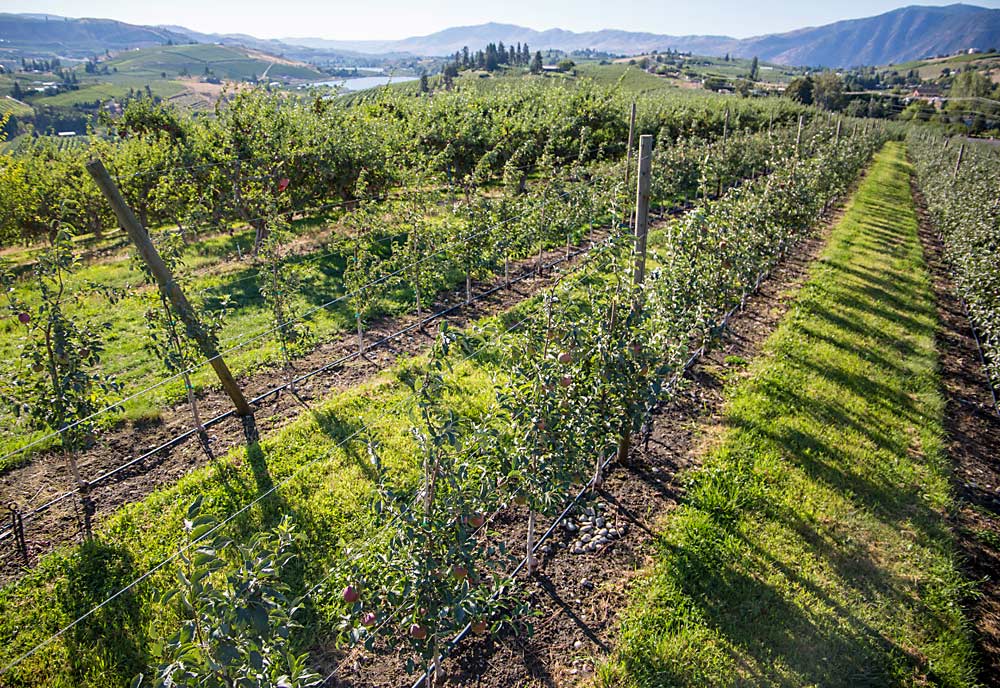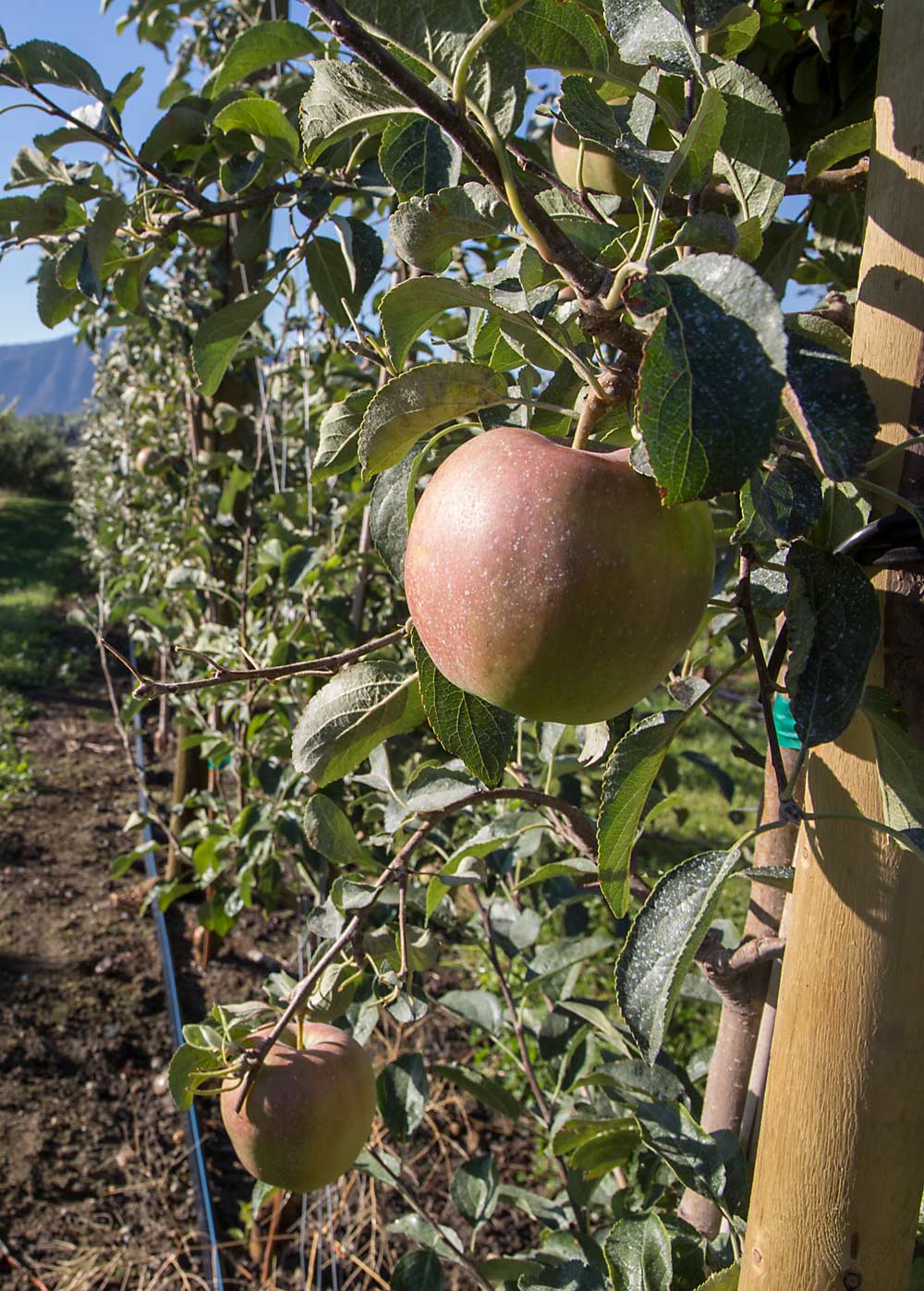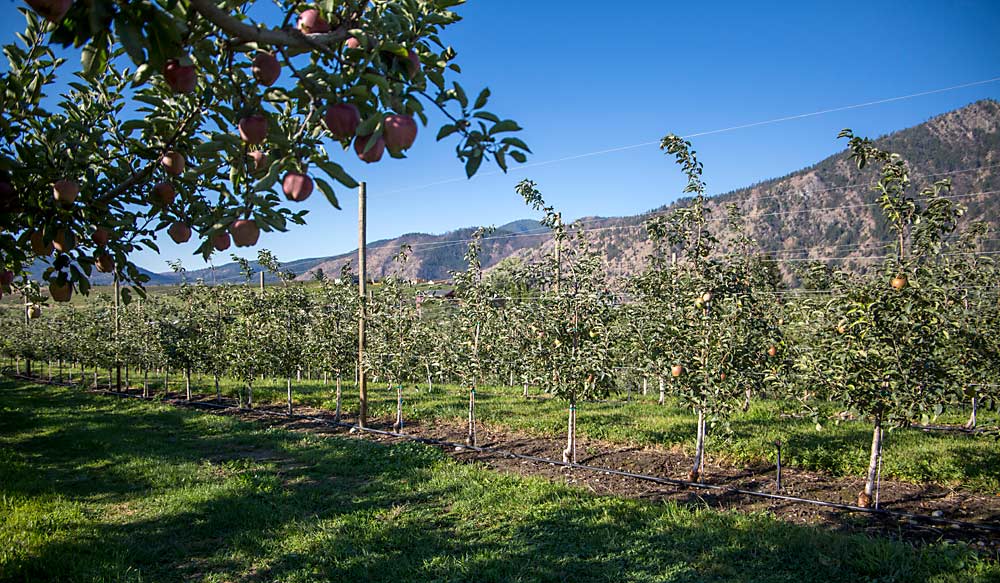
Somewhere between 1.6 million and 2 million boxes. That’s well over 100 million stems that should be clipped this harvest, in accordance with quality standards for Cosmic Crisp.
“We are strongly advising all growers to clip stems in the orchard this year,” said Jill Burbery of Proprietary Variety Management, the Yakima, Washington-based company managing the Cosmic Crisp program. “We cannot mandate it, but for the betterment of presentation and to increase their packouts, that is the thing to do.”
That’s one of the key insights from 2019’s first commercial harvest of WA 38, the apple marketed as Cosmic Crisp, that now informs the 2020 harvest in which growers expect to pick and pack fivefold more fruit than in the inaugural season. Other changes include a streamlined release schedule — no matter the tree age, fruit can be shipped as of Nov. 23 — and more specific guidance on how to use the starch scale and color grading to optimize fruit quality, Burbery said.
Burbery planned to share this information with growers during a virtual preharvest field day organized by Washington State University Extension in mid-September. Other planned speakers included postharvest physiologist Carolina Torres, horticulture professor Stefano Musacchi and extension specialists Bernardita Sallato and Karen Lewis, all from WSU, along with Ines Hanrahan, director of the Washington Tree Fruit Research Commission.
“It’s very rare to have an apple on the market with such a level of information in the second year of production,” Musacchi said. “What I learned from last year is that I would not delay the harvest of WA 38.”
Lewis echoed that: “We have a nice crop out there and we have a lot of it, so picking it at the right time is really important.”
WA 38 promises to be a single-pick variety, with harvest timing in late September through early October, 165 to 175 days after full bloom, but growers who let fruit hang too long risk increased cullage and greasiness developing in storage.

“It is a forgiving variety, but a starch index of 4.5 is a danger zone for senescence issues like greasiness,” Torres said. Some packers struggled with excessive greasiness in overmature fruit last season, she said.
This year, Torres and Hanrahan put together a chart to guide harvest decisions based on storage plans. Usually, Torres recommends using at least two maturity indices to account for year-to-year variability, but the starch index specifically developed for WA 38 is the most critical, she said. The firmness at harvest should range from 16 to 23 pounds.
Fruit picked before a 2 on the starch clearing scale can fail to develop good flavor, but fruit harvested above a 3.5 sees higher rates of splits, bird damage and the aforementioned greasiness, according to the guidance. Fruit destined for less than four months of storage can be picked between 2 and 4.5, but fruit going into long-term storage should be harvested between 2 and 3.
“We’re expecting more fruit is going to be stored longer this year,” Torres said. She recommends 1-MCP for fruit stored longer than six months, to reduce greasiness, but she’s not worried about how the fruit will fare in storage. “In small-scale trials, this fruit has been good for 10 or 11 months,” she said.
In another look at optimizing harvest, last year Musacchi designed a trial to compare six picks over the course of six weeks in a mature WA 38 block. Over time, fruit size increased but so did the risk of culls for bird damage and splits, he said. The percent of culls ranged from 8.2 percent for the first pick on Sept. 17 to 34.1 percent on Oct. 22.
“If you harvest too early, you have small fruit, so you don’t want to go there, but if you wait too long, you will have other issues,” he said, recommending the second, third and fourth pick dates last season, which ranged from Sept. 24 to Oct. 10, 2019, during which the fruit had average starch index scores of 2.2, 3.3 and 3.3, respectively. “The color, starting from the second pick, was already good, and the third and fourth pick, the color was really good.”
For the study, Musacchi selected trees to standardize the crop load, since trees with less fruit were usually ripe earlier, he said. “If you are not taking into account the crop load, it’s not really meaningful,” he said.
To assess the impact of crop load, Lewis recommended growers set aside some samples from light, medium and heavily cropped trees to conduct their own taste tests in November or December.
“It’s too late to adjust your crop load, but it’s not too late to have that experiment,” she said. “We know that crop load matters in Cosmic Crisp; it matters in any great eating apple.”
Adjusting crop load on WA 38 can be complicated, Musacchi said, as the variety self-adjusts to carry just one or two fruit per cluster. Cropping high, over six fruit per square centimeter of trunk cross-sectional area, can push the tree toward biennial bearing, but trees cropped too low can end up with higher levels of dry matter. Higher than typical levels of dry matter help WA 38 store well and retain good flavor and firmness, but if it’s too high, it can diminish the eating quality, Musacchi said.
“Crop load is affecting maturity, quality, dry matter, everything,” he said.

Once it’s time to harvest, that’s when the stem clipping comes in. Cull surveys last year showed stem punctures were one of the top problems. Because it’s a dense apple, the stems are quite woody, Burbery said.
“Although it’s a very hardy apple and does not bruise easily, that woody stem can cause a marking that can eventually lead to decay,” she said. “Stem clipping is going to have a strong impact on the length of time an apple can be stored.”
Before shipping, packers need to make sure that fruit samples score above a 5 on the starch scale and that background color is not a hard green, which is a sign the fruit is still immature, Burbery said.
PVM also tailored recommendations specifically for the 30 or so farmgate growers who market Cosmic Crisp at their own farm stands or small markets and don’t have to wait for the commercial release date.
“They don’t necessarily have the luxury of storing fruit, so we gave them guidelines for optimal flavor,” she said.
Without storage to let more starch clear, it’s even more important to hit the harvest time just right. PVM wants to make sure farmgate growers are in the loop on the best practices and new research, Burbery said.
“In Washington state especially, that’s the first glimpse consumers have of the Cosmic Crisp,” she said. “We want them to have a good impression.” •
—by Kate Prengaman
ONLINE
For additional resources, head online to treefruit.wsu.edu to find a new defect guide with photos of how common and unique disorders present in WA 38, as well as the starch scale. A recording from the virtual field day will also be available.






Leave A Comment